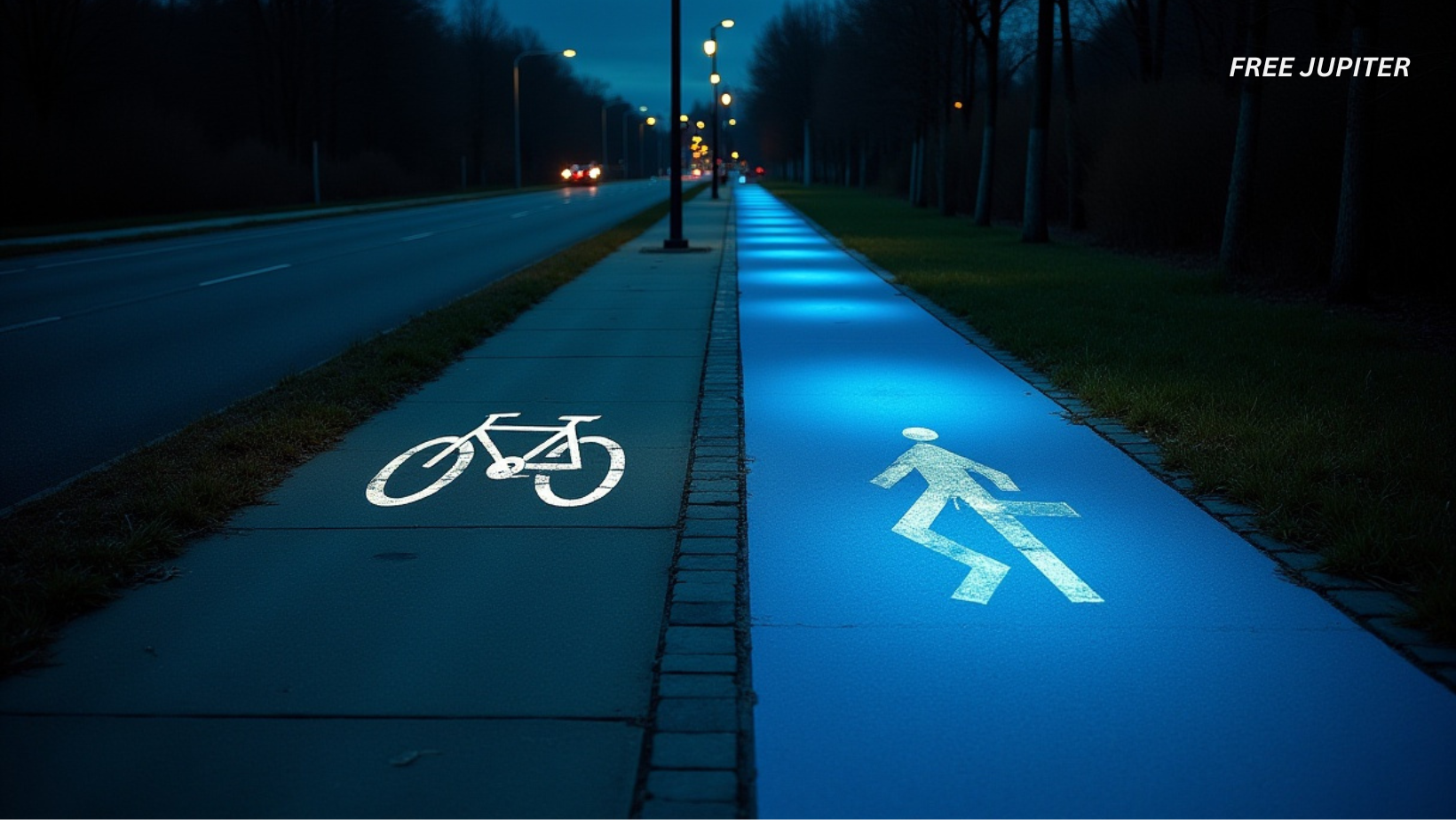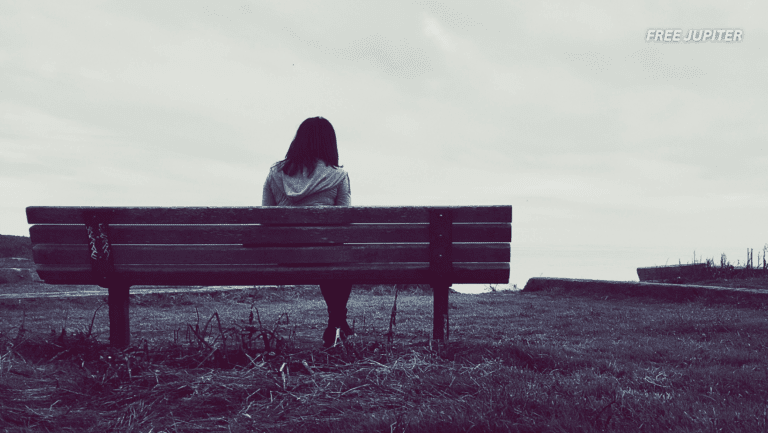Friendly Note: FreeJupiter.com shares general info for curious minds 🌟 Please fact-check all claims—and always check health matters with a professional 💙
Imagine cycling down a peaceful path in the middle of the night. The stars are twinkling above you—but below, the road itself is glowing with a soft, ethereal blue light. No streetlights, no noisy generators—just a glowing ribbon winding through the trees, lit by the power of the sun. Sounds like something out of a fantasy film, right? But in a small town in Poland, it’s already a reality.
This glowing bike path in Olsztyn, Poland, is part science, part art, and part environmental revolution. And it may just inspire the way we build roads, parks, and even cities in the future.
What Makes the Bike Path Glow?
At the heart of the glowing path is a clever bit of science. The surface is made with a special material called luminophore. These particles have a neat trick: they soak up sunlight during the day and then emit a soft glow at night—no electricity, no switches, and no batteries required.
The material is mixed right into the concrete, creating a durable and self-illuminating pathway that can shine for up to 10 hours after sunset. In the Olsztyn installation, the glow is a calming shade of blue, chosen not just for beauty but also because it’s gentle on the eyes and doesn’t interfere with local wildlife.
Read more: Injectable Hydrogel Literally Found to Increase Bone Density by Up to 5x, Study Shows
Why Glowing Paths Matter
At first glance, this might seem like just a pretty novelty. But there’s more to this idea than aesthetics.
Most of the roads and paths we use today rely on traditional streetlights, which may seem harmless—but they come with a surprising environmental cost. Bright artificial lights can confuse or even kill insects like moths and beetles, disrupt bird migrations, and affect how animals hunt and mate. This is part of what scientists call light pollution, and it’s a growing problem in both cities and the countryside.
By using paths that glow softly rather than shine harshly, we can help cut down on that light pollution—especially in rural areas where ecosystems are more sensitive and infrastructure is less developed. It’s a win-win: safer travel at night, and a lighter touch on nature.
A Small Step in Poland With Big Potential
The glowing path in Olsztyn is only 100 meters long—roughly the length of a soccer field. It was intentionally built as a test patch to see how the material would hold up over time, especially through harsh Polish winters. If successful, the creators hope to extend it further and bring the technology to other parts of the country.
The project was developed by TPA Sp. z o.o., a European construction company experimenting with sustainable infrastructure. Their hope is that these kinds of designs will become more mainstream, not only because they’re energy-efficient but because they make public spaces more inviting and enjoyable.
Inspired by a Starry Masterpiece
This isn’t the first glowing bike path to turn heads. The inspiration for Poland’s design came from a dazzling project in the Netherlands.
Back in 2014, Dutch artist Daan Roosegaarde teamed up with construction firm Heijmans Infrastructure to create a glowing bike path inspired by Vincent van Gogh’s painting Starry Night. The result was a swirling, dreamlike trail made with solar-powered LEDs and special paint, forming part of a longer bike route in the province of North Brabant, where Van Gogh was born.
Unlike the Polish path, the Dutch version relies on a combination of solar-powered lights and luminous materials. It creates a more artistic pattern on the ground, designed to mimic the motion and stars of Van Gogh’s famous painting. The Dutch installation wowed visitors and quickly gained global attention for its blend of art, tech, and sustainability.
Read more: Scientists Warn: Don’t Strip Moss Off Surfaces—It Absorbs Four Times More CO₂ Than Trees
Other Glowing Roads Around the World
Poland and the Netherlands aren’t the only places playing with light. Around the globe, several projects have experimented with glow-in-the-dark and solar-powered roads:
- China tested solar-powered roads in Jinan, where panels beneath a stretch of highway generated electricity and could even charge electric vehicles as they passed.
- In France, the village of Tourouvre-au-Perche installed a solar panel-paved road, though it faced challenges with cost and durability.
- In the Philippines, local students developed eco-friendly pavement tiles made from recycled plastic and glow-in-the-dark powder—offering a cheap and accessible option for communities with little access to reliable electricity.
While not all of these experiments have been perfect, each one adds valuable insight into how our future streets might be built—combining sustainability, safety, and style.
Lighting the Way for Rural and Urban Areas Alike
One of the most promising uses of glow-in-the-dark paths is in rural communities. Many of these areas lack proper street lighting due to budget limits or environmental concerns. Building electrical infrastructure across long stretches of countryside can be expensive, invasive, and unsustainable.
With glow-in-the-dark paths, however, all that’s needed is some sunshine—and a good mix of durable materials. These paths could help make evening walks, bike rides, and even commutes safer for pedestrians and cyclists, without relying on energy-hungry streetlights.
But cities might benefit too. Imagine public parks, riverside walkways, or school routes that light up gently at night, guiding people without blinding them. These subtle glows could help improve safety while making urban areas more visually appealing—and even reducing crime in dimly lit spaces.
Looking Ahead: Could Entire Cities Glow Gently at Night?
As this technology matures, it’s easy to imagine entire neighborhoods or even cities adopting glowing surfaces—especially in zones that don’t need full-blown lighting, like bike lanes, jogging paths, or pedestrian-only streets.
Of course, there are challenges to overcome. Glow-in-the-dark materials need to withstand rain, snow, and wear-and-tear from foot and bike traffic. They also need to be affordable and easy to install. But as demand for eco-friendly solutions grows, so too will innovation.
We may even see multi-colored paths that signal different routes or glow brighter in certain areas, or interactive pavement that lights up only when someone walks over it—kind of like a light-up dance floor for your daily commute.
Read more: Cuddling For Only 30 Minutes Lowers Stress and Strengthens Your Heart, Study Finds
In the End, It’s About Rethinking How We Use Light
For most of human history, light has meant fire, then electricity. But today, we’re seeing a shift toward natural, passive lighting systems—ones that use what’s already available (like sunlight) and avoid creating more waste or pollution.
Poland’s glowing bike path is a small but shining example of how innovation doesn’t always mean complicated gadgets or sprawling tech. Sometimes, it’s about rethinking everyday things—like a bike path—and asking, how can we make this better for people and the planet?
So next time you ride your bike at dusk, imagine a world where the ground beneath you quietly glows, guiding your way—not with blinding beams, but with the soft, sustainable touch of light borrowed from the sun.










